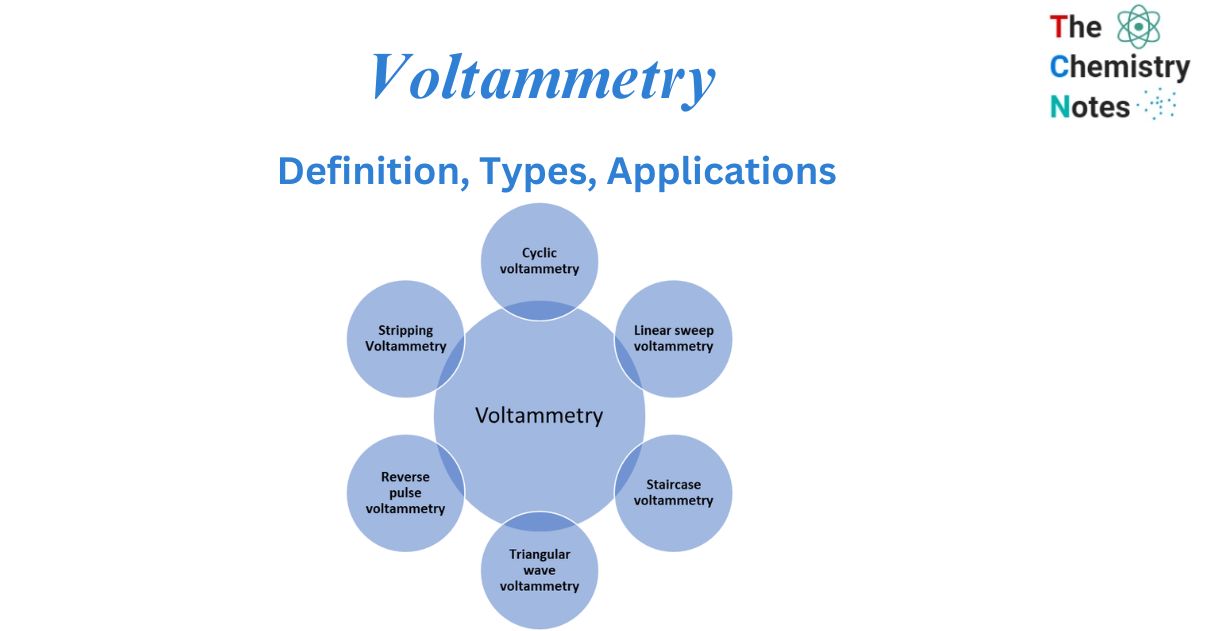
Voltammetry refers to electrochemical procedures that include applying a specified voltage profile to a working electrode as a function of time and measuring the current produced by the system. This is typically done with a potentiostat, which is capable of applying varying potentials to the working electrode relative to a reference electrode (such as Ag/AgCl) while measuring the current that flows as a result of the electrode reaction.
Voltammetry can be used to analyze a wide range of molecular and ionic compounds, both qualitatively and quantitatively. A set of two or three electrodes is dipped into the analyte solution in this approach, and a regularly fluctuating potential is provided to the indicator electrode relative to the reference electrode.
All voltammetric procedures have one thing in common: they require applying a voltage (E) to an electrode and measuring the consequent current (i) flowing through the electrochemical cell. In many circumstances, the applied potential is changed or the current is measured over time (t).
The word “voltammetry” is now used to refer to all methods for measuring current as a function of electrode potential. Jaroslav Heyrovsk was its pioneer, who developed a voltammetric technique that he called polarography.
Voltammetry is developed from voltamperometry and expresses the measurement of current as a function of voltage, i.e., electrode potential.
Types
Cyclic voltammetry
Because it provides a wealth of experimental information and insights into both the kinetic and thermodynamic dynamics of many chemical systems, cyclic voltammetry is widely employed. The current response of a redox-active solution to a linearly cycled potential sweep is measured using cyclic voltammetry.
Linear sweep voltammetry
Linear sweep voltammetry is a simplified version of cyclic voltammetry that uses only a single linear sweep. Linear sweep voltammetry is a broad term for any voltammetric method in which the voltage delivered to the working electrode changes linearly with time. A potential scan is performed in Linear Sweep Voltammetry from the begin potential, E begin, through the end potential, E end. Although the scan is not strictly linear, small potential steps (E steps) are taken.

Staircase voltammetry
Staircase voltammetry involves holding an electrode at a constant voltage and measuring the current after a delay. The potential is then changed, and the current is measured once more. The potential step and current recording are repeated over a specific potential range. The potential change is linear in both magnitude and direction, resembling a staircase.
Triangular wave voltammetry
Triangular wave voltammetry is a process in which the potential is linearly scanned to a value beyond the potential at which an electrochemical reaction occurs and then instantly scanned back to its original potential. A triangular wave voltammogram typically contains a forward current peak and a second, inverted peak on the reverse scan representing the opposite reaction (oxidation or reduction) to that recorded on the forward scan.
Reverse pulse voltammetry
Reverse pulse voltammetry (RPV) is a highly useful electroanalytical technique when measuring currents of direct reduction or oxidation of substrates complicated by poorly defined waves. It is also highly effective in studying chemical reactions that are connected with electrode operations.
The distinction with normal pulse voltammetry is due to the potential outside the pulse and the direction in which the pulse is applied. While the potential outside the pulse in normal pulse voltammetry is designed so that no electron transfer takes place, the potential outside the pulse in reverse pulse voltammetry is designed so that the current is at its highest. Furthermore, in reverse pulse voltammetry, the applied pulse decreases current flow rather than increasing it, as in normal pulse voltammetry.
Differential pulse voltammetry
A sequence of pulses with sequentially rising baseline voltage is given to the electrode in differential pulse voltammetry. The current is sampled by the system just before the next pulse is applied. One of the first electrochemical approaches for detecting catecholamines was differential pulse voltammetry. Small amplitude, short pulses are superimposed on a linear ramp in differential pulse voltammetry (DPV). The current is measured both before and after the pulse is applied, and the difference between the currents is determined.
Square wave voltammetry
Square wave voltammetry is a large amplitude differential technique that applies to the working electrode a waveform made of a symmetrical square wave overlaid on a base staircase. A waveform in square wave voltammetry comprises a staircase scan, with each trend superimposed by a symmetrical double pulse, one in the forward direction and one in the reverse direction. Square wave voltammetry is a sort of pulse voltammetry that reduces the capacitive background current of the working electrode while increasing the signal-to-noise ratio of the oxidation and reduction waves’ Faradic currents.
Rotated electrode voltammetry
Electrodes can be made to spin, which modifies the way chemicals diffuse as well as the recorded current. The key advantage is that a steady state is attained quickly, and mass transmission is faster. The faster the mass transfer, the greater the currents from particular electronic processes.
Stripping Voltammetry
Stripping voltammetry is a highly sensitive electrochemical method for identifying trace elements. It employs two potential values; oxidation happens at one potential value and reduction occurs at another. Stripping voltammetry (SV) is based on the preconcentration of the analyte onto or into the working electrode, followed by a potential scan during which the analyte is stripped back to the solution; the current response is proportionate to its concentration.
Applications
- Voltammetry can also be used to characterize an analyte’s properties, such as identifying its electrochemical reversibility, the number of electrons transported during oxidation or reduction, and the equilibrium constant in a linked chemical reaction.
- Cyclic voltammetry can provide information regarding the chemistry of redox pairs. This is probably the most appealing aspect of this strategy.
- It is also used for the determination of metal ion concentrations in water to sub-parts per billion levels.
- Pharmaceutical evaluation
- Environmental Research
- Biological/Biochemical Examination
References
- https://link.springer.com/article/10.1007/s40828-015-0016-y.
- https://www.britannica.com/science/chemical-analysis/Electroanalysis
- https://www.brown.edu/Departments/Engineering/Courses/En123/Lectures/potentiostat.pdf
- https://chem.libretexts.org/Bookshelves/Analytical_Chemistry/Supplemental_Modules_(Analytical_Chemistry)/Analytical_Sciences_Digital_Library/In_Class_Activities/Electrochemical_Methods_of_Analysis/02_Text/7%3A_Electrochemical_Analytical_Methods/7.5%3A_Voltammetric_Methods
- https://www.slideshare.net/shobana3/voltammetry-43392583
